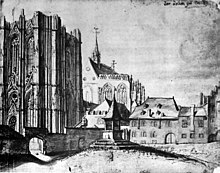Cologne fountain
The construction Cologne wells protections provided by Roman origins of the city as Colonia Claudia Ara Agrippinensium until the conclusion of the 19th century, the water supply of the city of Cologne . When the first municipal waterworks went into operation in 1872, the function of the new wells and water systems changed. They no longer served primarily to draw water, but became decorative buildings in the city district.
Fountain story
Roman times
The first well systems and their use in the city's Roman times are documented for the 1st century. The technical standard of this water supply (including disposal), which was at a high level at that time, was lost when the facilities began to decline after the Romans withdrew, and was not achieved for centuries. Evidence for this are a number of exposed wells and sections of the Eifel water pipeline that was built during this time , as well as the remains of the sewers that were formerly used.
The Romans built their wells by digging wide pits deep into the groundwater . There, a square of cut oak planks was set in around the collecting water, on which a well shaft made of tufa blocks was built. The blocks, which were cut to fit by stonemasons , managed without any bracing or the use of the building material Opus caementitium ("Caementum"), which they used as a binding agent , and thus prevented the new drinking water well from being contaminated by external influences after the excavation was refilled.
The high standards achieved, also in the hygienic area, are underscored by the foundations of a circular building on Cäcilienstraße, which were uncovered in 2007 and which were part of a Roman thermal baths . Older archaeological finds, but also the uncovering of ancient wells in recent times (2008) on the town hall square and as a result of the excavations around the construction of the north-south light rail at Klein St. Martin , illustrate the difference in the water supply to today's standard. These fountains, apart from the ritual facilities of the early Jewish communities in Cologne, such as the mikveh at the town hall and the one in Deutz (today under the entrance to the Deutz bridge ), were purely useful facilities for centuries.
Early middle ages
With the conquest of the Roman province of Lower Germany and the entry of the Franks into the Roman city around 355, the cityscape was changed by the new masters, who now built their rural culture on a destroyed urban being.
Nothing is known about the city's water supply, which was then in use from the 5th century until the late Middle Ages . In addition to the withdrawal of water from the Rhine , at that time there were still some waters flowing into the Rhine from the surrounding area, such as the Duffesbach , from which the inhabitants of Cologne supplied themselves with drinking and service water. Overall, the water supply was probably retrograde as a result and must have been quite primitive and arduous. Scoop or draw wells, the first documented mention of which appeared in the Cologne shrine books around 1130 , were then the standard that was to be the rule well into modern times . They were called Pütze in Cologne.
Medieval fountain
sewage
The exemplary system of Cologne's water disposal system, which was left to the residents of the city after the end of the Roman era, probably fell into disrepair during the Frankish period. Some parts of the street that still exist today (Budengasse) were no longer used and were replaced by the simple discharge of sewage from the houses onto the mostly unpaved roads. The rivulets called “sods” in Cologne collected depending on the gradient in so-called standing puddles, or found their way into the Rhine. The faeces from the frequent animal husbandry were used to fertilize the fields, and human excrement created a new profession. It was the people who emptied the latrines of the houses at night and disposed of the freight from their filled transport containers in the Rhine. The Rhine, which was used for waste disposal (other places on the Rhine also did the same), had become unusable for drawing drinking water. The few streams that reached the city were usually used commercially and were also contaminated by discharged sewage. In medieval times, a large number of wells built throughout the city took care of the people and their pets.
Quality of the well water
However, the water quality of the Pütze was poor in many cases. The wells, which also stood in the courtyard as well as the septic tanks of the latrines , as well as the numerous puddles filled with rubbish, dirt and rubbish, impaired the groundwater and thus also the quality of the well water drawn from the depths.
The number of puddles was high and still exist today as street names. Many of these swampy ponds formed in the trenches in front of the former Roman city walls. For example, the Perlengraben and the old ditch (Eintrachtstrasse), the large swamp behind today's Weidenbach, the Pfuhl on Schnurgasse at "Schallenbergs Weingarten", the Pfuhl im Laach (= lacus), the Rinkenpfuhl, the "Cradepoil" at the “Schultheißgasse” (S. Peter district), the Entenpfuhl, the Perlenpfuhl or the Pfuhl at the end of the Thieboldsgasse.
Baptismal font
The Jewish history in Cologne goes back to the year 321. The life of this population group, with their ancient traditions, was an integral part of urban life. It was not until some time later that the Christian faith gained a foothold in the Rhineland, so that Christians and Jews drew their lessons from the Old Testament . A striking example of this fountain shape is the "blood fountain" of the Machabä monastery , which came from the early days of the pronounced martyrdom in Cologne. A cast iron stove plate in the chimney wall of the Carthusian Church was part of a baroque “Bible oven” from around 1625. Its relief shows Christ and the Samaritan woman at the well.
Puteum iudeorum
A document from the Jewish shrine book kept in the district of the Laurenz parish dates from 1270 , in which the location ad puteum iudeorum (Latin puteus = fountain) at the Judenpütz was used for the house of a Livermanus . The text translated from Latin reads:
It is known to both the future and the present that Livermann, a Jew from Düren, has built a new building on the square on Judengasse near the passage where you go to Judenpütz across from Mar (s) porze
In the same context, a nearby washing stone was cited, a lapis lavatorius , on which ritual washing of the dead ( tahara ) was carried out with the water from the mikveh there . The document ends with the date:
happened in the year of Lord 1270 on the next morning of the day of St. Severin (October 24th)
Council well
The wells erected at the city gates and towers, as well as those of the city slaughterhouse, were subordinate to the council itself. The costs caused by these wells were paid for by the Wednesday rent chamber.
Drinking water of the citizenry
The water supply of the Cologne population in medieval times was provided by draw wells. A building used for residential purposes, a so-called Pützhaus, often rose above a larger fountain. Smaller of these systems were raised on a stone stair landing and were often provided with a tower-like attachment. Two drawings by Justus Finkenbaum (around 1665) show such systems. There is a Pützhaus on the Cologne Cathedral Monastery (today's Domplatte ), whose existence (possibly in a different design) was mentioned as early as 1465, and another next to the Church of St. Maria in the Capitol .
A fork with a rod, the length of which was adapted to the depth of the well, belonged to the equipment of the well, which is called Pütz in Cologne dialect . A bucket attached to the pole and a tub that took up the water drawn from the depths, which is still called “Bütt” in Cologne, initially completed the initial equipment. In later times, the rod technology was replaced by rope winches, which were followed by chain winches, also known as wheel chocks.
Craft of the Pützmaker
The construction of the wells and the repairs that had to be made to them had given rise to a special profession in Cologne. It was the trade of the “cleaning workers” (not to be confused with the cleaning workers) that was mentioned in many municipal documents.
Wells and fire protection
Wells supplemented remote running waters as reservoirs for extinguishing water in the case of frequently occurring fires . With the materials used to build houses (wood, half-timbered ) up until the early modern period , a comprehensive system of wells had become a necessity for fire protection that had grown out of experience .
Relatively few houses in the city had their own well, in one such case in the courtyard or garden. However, bakeries and breweries all had their own wells, as indicated by the provisions of a fire ordinance issued in 1360. This stated that in the event of a fire, the houses of the bakers and brewers had to be opened in order to enable access to the "Pütz".
Well right
There were so-called fountain communities far more frequently in the city. If a larger house community or a community of neighboring houses came together, a well- fair could be obtained with a minimum of seven "witnesses" . In this case the costs of a new building, the repairs and the wear and tear had to be taken over proportionally.
A well was often used for the common use of the residents of two neighboring houses, the owners of whom contractually agreed on all modalities . If a jointly used well lost its open access due to structural changes, for example through the erection of a property wall or a partition wall called “Britz” in Cologne, an access path that was prescribed in its width had to be built, with the agreed access rights to the shrine register of the responsible district was entered. If the well property had a lockable gate, in these legal stipulations the ownership of the keys was linked to the sole assumption of the repair costs of the well.
First water pipes
In order to rule out such quarrels, but also to simplify and reduce the workload, supply lines were built. Often houses, but mostly businesses such as bakeries, dyers, workshops and others with high water consumption, had facilitated their water supply through an underground channel or wooden channels (kallen) from the well. The natural course of the Duffesbach was also intervened by creating artificial diversions. This is illustrated by the drawings of Arnold Mercator , who in 1571 depicted the city very precisely.
Cattle troughs
Drinking troughs specially set up for the cattle were mostly set up in places where cattle markets were held in large squares or wide streets. Their facility also served the riding horses or the draft animals harnessed to carts and wagons. The larger of these types of troughs were on the Alter Markt , the Heumarkt , the Waidmarkt in the suburb of Oversburg and the Neumarkt in the 16th century. More of these facilities were located on the “Gereonsdriesch”, in front of the “Spiegeler Hof” on Machabäerstraße, on Mauritiussteinweg on Marsilstein and on Weidenbach. In front of the city there was another drinking trough on the Judenbüchel road leading to Bonn .
Public wells and payers
Wells on the street, even if they belonged to a house, could also be used by the neighborhood. The public fountains were increasingly located on long streets, they were often found in the corner of two houses, on broad streets or squares they stood in the middle. But they were also found in dead ends, which were often called "Pützgässchen" or "Pützhof". The name of today's street Klingelpütz , in the northern part of Cologne's old town , is to be seen in this context. The description of the place says in 1457:
.. and is located in the Spilergasse, where one goes from the Aldergraven to the Klyngelputz, on the side to the chapel of our Lords corpse with half of the Pütz and with the houses and vineyards behind with all their accessories .
The term “public” referred to the classification as “vicinal property” from which a general right of use was derived, but the costs incurred had to be borne by the immediate neighbors. The city council exercised the supervision of the street plaster and occasionally ordered revisions. A commissioned "Tirmtmeister" stopped the neighbors to emergency construction of the wells when defects were found. Made complaints of the neighbors, who accused one of them as deniers of cost sharing, carried out the seizure of the defendant. Requests addressed to the council by residents to provide stones or equipment for building a well were refused by the council even in emergencies. This had occurred in the "Schartgasse" (Schoresgasse), in which in 1576 a well had collapsed. He referred to a precedent from 1472 in which the council had advised the citizens of the neighbors' obligation to repair and rejected such requests once and for all.
Well as namesake
Gesundbrunnen is the name of numerous German villages or localities. The family name Pütz, which is common in the Rhineland, refers to the countless, also named draw wells of the cities in ancient times and has its origin in the Latin language. However, the wells were often the namesake of a well resident or the owner of one. The family of the wife of the Cologne mayor von Groote , a née Maria von und zum Pütz , depicted a fountain in their coat of arms . Even today the name Pütz can be found as a synonym in family and street names (Pütz, zum Pütz, Pützgasse, Klingelpütz, and Pützchens Markt ). An earlier sub-district of the shrine of the parish of St. Peter was the Pützhof on the Greek market, south of Cologne's Neumarkt .
Modern fountain techniques
The memorial plaque of Maria von Groote clearly shows the pulley technology used in the Baroque period . It was the more modern form of the so far customary, winch- equipped "wheel hoods", in which a bucket was let down on a rope (later a chain) and then filled up by a wheel or roller. Only later, with the suction pump developed in 1745, was this technology gradually replaced.
Modern fountain
The depictions by Justus Finkenbaum from around 1665 already show a first approach that shows the departure from a purely functional construction of the wells. However, these examples will not have been the rule for all systems. The illustrations show towers or dome structures attached to a balustrade surrounding the fountain , which were equipped with an additional decorative crown . They highlighted the buildings and made the decorated fountains an eye-catcher and focal point of a courtyard or square in the public life of the city.
End of the draw well
On September 4, 1867, the Cologne cathedral builder Richard Voigtel presented the fountain project for the Petrusbrunnen to the Upper President of the Rhine Province, who approved it on September 17, 1867. Before that, Empress Augusta had taken over the financing of the construction costs as a foundation. The statue of St. Peter came from cathedral sculptor Peter Fuchs , it stood in a water basin with a diameter of 7.50 meters. In May 1870 the structure was erected at the foot of Cologne Cathedral on the edge of the Old Botanical Garden on the east choir (Rhine side). The fountain, built on the former site of the abandoned church of St. Maria ad gradus (1817), was the first decorative fountain in the city to be built for purely representative purposes. The fountain stood on the lower level of Frankenplatz; it was architecturally framed by the substructures of the flights of stairs and the terrace.
The construction of this well coincided with the construction of the first Cologne waterworks , which went into operation in 1872 after three and a half years of construction work on the "Alteburg". Up to this time, with the exception of the water supply from Duffesbach, which came from Hürth , 250 public and around 500 private wells were in operation in Cologne and supplied the population with drinking and service water.
The Petrusbrunnen remained at this location in the east of the cathedral until 1969. As part of the redesign of the cathedral plate , it had to move in autumn 1969 and then stood between the cathedral sacristy and the cathedral choir (towards the station hall ). In 1999 it was then dismantled for restoration. On the "Pope Terrace" (south aisle of the cathedral) it has now been raised to the level of the cathedral plate and inaugurated on July 3, 2010. His nickname “Drüje Pitter” (“dry Peter”) came about because the fountain rarely carried water after it was installed in 1870.
Thermal fountain and medicinal water
In search of drinking water they found what they were looking for in a 1912 drilling in Cologne-Stammheim at a depth of 70 meters. It was, however, carbonated and chloride-rich mineral water . As a result, the thought arose that the city could become a kind of spa .
In 1931, under Mayor Konrad Adenauer, the 251.40 meter deep exhibition fountain I was drilled on the exhibition grounds . A mineral-containing water could then be pumped from this. The mineral water was developed at a depth of 235 m. The drilling of Messebrunnens II, however, remained meaningless in terms of its productivity. In 1932, both springs were declared non-profit within the meaning of Section 1 of the Spring Protection Act of May 14, 1908, but contrary to the recommendations of the experts, a medicinal spring protection area was not established. Due to corrosion damage to the piping of both wells, a comprehensive rehabilitation of the boreholes had to be carried out in 1959, without achieving corresponding successes in increasing the output. The decision was then made to drill a new hole 50 m from Messebrunnen I. The 364 meters depth of the exhibition fountain III, which was then reached in 1961 and 1962 with better technology, then brought up to 200 m³ / h of thermal carbonated sodium chloride water. Even with a sum of half a million DM already spent , the goal of finding a groundwater reservoir with higher water temperatures had not been achieved, so the city council stopped work on developing a thermal spring . However, the city administration allowed work to continue later, initially without informing the council. Around 1967 the fair fountain IV was successful with a depth of 1027 meters then great technical efforts drilled . In order to prevent the inflow of cold water from the upper part of the borehole, the borehole was sealed with steel tubing down to a depth of 724 m. A sodium chloride thermal bath with a temperature of 28.5 ° C has now been extracted from borehole IV. With this rather moderate value compared to other German thermal baths ( Aachen 74 ° C, Wiesbaden 66 ° C.), The minimum requirements for thermal water (temperature> 20 ° C) were met. The thermal water is bound to Devonian limestone and dolomite stones , which absorb rainwater in the Bergisches Land . The seeping water circulates according to the hydraulic gradient in the direction of the Rhine , warms up according to the geothermal depth and absorbs dissolved minerals and free carbon dioxide (up to 2000 g / l).
For example , a thermal bath was opened in January 1971 in the northeast corner of the Rheinpark , on Sachsenbergstrasse, where the promoted medicinal water of a healthy fountain was offered to visitors for the 1957 Federal Horticultural Show , after three quarters of construction . In 1975 the spring was officially recognized as a healing spring, as its water contains nine other minerals in addition to table salt . The three-story building, which is under private management, burned to the ground in August 1986. The new facility built after many years at the same location, today's "Claudius-Therme", is available for its thermal operation in the Messebrunnen III and IV.
Gardens and water facilities
Between 1827 and 1828, the first planned green area was the Stadtgarten (Cologne) based on a park design by Jakob Greiß . In addition to Adolf Kowallek , who took over the planning of the greenery in Cologne's Neustadt as the new Cologne gardening director in 1888, it was Fritz Encke (1861–1931) who did a lot for Cologne's green spaces and public gardens . The approximately 4 hectare Aachener Weiher in the inner green belt was created in 1924 by Fritz Encke. Today the Museum of East Asian Art with its traditionally designed water garden is located on it.
The “Outer Green Belt” project, which was part of Schumacher's planning and included smaller bodies of water as well as the Adenauer and Decksteiner ponds , was completed by Fritz Encke in 1929 after the general plan was revised by Theodor Nussbaum (gardening office). Encke, who received active support from Cologne's Lord Mayor Konrad Adenauer , created numerous Cologne squares, which are often decorated with fountains by well-known artists even today. The botanical garden created by Peter Joseph Lenné in 1863 , the Flora in Cologne-Riehl , with its many different water features integrated harmoniously into the complex, is an example of the art of garden architecture of that time.
As in this part of the city, other suburbs competed with new systems. In the new Cologne-Lindenthal district , a pond was created according to plans by the garden architect Maximilian Friedrich Weyhe (1775–1846) in the middle of the Cologne city forest that was created between 1895 and 1898 . The pond, now equipped with a mighty water fountain, was completed by gardening director Adolf Kowallek, as was the Volksgarten , which is also equipped with a water feature and is located in the southern part of Cologne .
The Cologne Rheinpark has also been provided with a fountain. A first park was created there in 1912 after the razing of the inner fortress ring in rechtsrheinischen Cologne green belt . It was given its present form by horticultural director Kurt Schönbohm for the Federal Horticultural Show in 1957. In 1964 the forest botanical garden was created . The park, located in southern Rodenkirchen , is around 25 hectares today and has a beautiful water system in its center.
The construction of the local recreation area Fühlinger See in 1967 in the far north of the city and the newest artificial ornamental water, the installation at the MediaPark , are the continuation of the urban green policy, as it was practiced by the urban planner Fritz Schumacher, appointed by Adenauer, in the years 1919 to 1922 .
Squares and ornamental fountains
Probably as a result of industrialization, around the end of the 19th century, the era of ornamental fountain architecture began in Cologne. The city wall fell, city architect Stübben planned and implemented under Cologne's mayor Hermann Becker , squares and, in some cases, lush green spaces on the new ring roads , with fountains in the northern part. But the city center was also equipped with new fountains. Some of these facilities, which were often the center of a square or the core of an architecturally designed green area, are still preserved today, for example the well-known Jan-von-Werth -Brunnen ( 1884) on the Alter Markt , the Hermann-Joseph-Brunnen (1894) at the Waidmarkt and the Heinzelmännchen fountain (1899) Am Hof.
Cologne only experienced a renaissance of ornamental fountains in the 1960s to 1980s.
Well-known artists
- Wilhelm Albermann (1835–1913) • Franz Brantzky (1871–1945) • Ewald Mataré (1887–1965) • Gerhard Marcks (1889–1981) • Georg Grasegger (1893–1927) • Eduard Schmitz (1897–1965) • Karl Band (1900–1995) • Joachim Schürmann (* 1926) • Hans Karl Burgeff (1928–2005) • Heribert Calleen (1924–2017)
Former fountain of the imperial era
- The central Barbarossaplatz, named after Friedrich I. , towards which the streets led in a star shape, was equipped in its center with a large fountain surrounded by trees and lanterns. The huge round pool was surrounded by a narrow green strip with flower beds within a lattice fence erected towards the square. A powerful, multi-jet fountain rose from the basin.
- The Kaiser-Wilhelm-Brunnen, which was destroyed on the Kaiser-Wilhelm-Ring during the Second World War, was built in 1897 based on a design by Richard Anders. From a large water basin, on a base made of lava stone, rose the statue of the emperor in victory pose , with an open rider's coat and general uniform. The sides of the well stock, made of reddish granite, were decorated with figures below the rider. The front was adorned with a seated female figure who held a laurel wreath as a sign of victory and wore a crown in the shape of the former city fortifications . Further representations were a slender pinnacle of Cologne Cathedral , a comb wheel , which was supposed to symbolize the hard work of the Cologne citizens , and a sculpture of the "Father Rhine" with a trident in his left hand . With the other hand, he was leaning on an amphora that had been decorated with images of Rhenish legends . All figures, like the equestrian statue, were cast from bronze . Two attached panels, also made of bronze, were provided with inscriptions. One praised the emperor, the other expressed the city's gratitude. Under the panels there were half-shells, above which gargoyles like lions' heads started the water cycle of the fountain.
- The animal protection fountain was built in 1913 based on a design by Johann Baptist Schreiner (he also created the Kolping monument in Cologne ). Leonhard Emanuel from Munich donated 10,000 marks to finance the fountain, which was then built at the entrance to the Volksgarten in Cologne . However, he made the condition that animal welfare should be addressed with the work. A round basin at ground level was created from which an oval stone well rose. On it the artist placed a group of figures made of bronze, which represented a woman standing in front of a deer. A shell-shaped gargoyle was attached to the lower well, which led the water into the basin. An inscription above the mussel shell warned the viewer: "Have mercy on the animals".
Examples in today's cityscape
Downtown
Old town north
| investment | Location description |
|---|---|

|
A fountain equipped with a river god mask made of basalt lava on the old Roman port road in 1975 . The original mask is an exhibit in the Roman-Germanic Museum . |

|
Historical City Hall Cologne , Rathausplatz Petersbrunnen (1662), 1st floor, handling of the Löwenhof.
The baroque alabaster surround of the Petersbrunnen was created by Heribert Neuss in the 17th century. It was a part of the frame of a former Marien altar in the cathedral (St. Peter). The lion head and the clam shell were designed by Eduard Schmitz at the beginning of the last century . |

|
Historic old market with town hall, town hall tower. In the foreground the market fountain (steel engraving around 1850). |

|
Jan-von-Werth-Brunnen in the middle of the old market . The fountain with the monument to Jan von Werth , built in 1884, was designed by Wilhelm Albermann . |

|
The Hermann-Josef-Brunnen on the Waidmarkt was created in 1894 by the sculptor Wilhelm Albermann, who died in Cologne in 1913. |

|
Heinzelmännchenbrunnen , “Am Hof” street in Cologne's old town. The fountain was donated in 1899 by the Cologne Beautification Association on the occasion of the 100th birthday of August Kopisch (1799-1853). An original figure of the fountain is in the Cologne arsenal . The fountain, created between 1897 and 1900, is the work of Edmund and Heinrich Renard |

|
Well pillar known as Siemens pump on the corner of Dagobertstrasse at Am Krahnenhof. The previously built wells were gradually replaced by pumps from the middle of the 18th century. The fountain shown here also comes from this time, but was re-erected on Dagobertstrasse. |

|
The fountain dedicated to Clemens of Rome stands on the edge of Kunibertsklostergasse between the local Marien Hospital in Cologne and the church of St. Kunibert , the origin of which was a church building consecrated to the Roman bishop Clemens I. The St. Clemensbrunnen was created by Titus Reinarz , a German sculptor who lives in Sinzig . |

|
Roman fountain between the castle wall and Zeughausstraße next to the Cologne City Museum . The Roman fountain was created by Franz Brantzky (1871–1945) between 1910 and 1915. The modified reconstruction after the destruction in World War II took place according to the design by Karl Band in the months of July to December 1955. |

|
Fountain in front of the building of the District President of Cologne , Zeughausstrasse. A 10.25 m high metal stele by Henryk Dywan has graced the official residence since 1982. The well system is not in operation |

|
The "animal fountain", designed by the office of Prof. Joachim Schürmann (* 1926), is located in Cologne's old town on the north side of the church Groß St. Martin . |

|
The Ostermann fountain was built in 1938/39 in memory of the Cologne folk song poet and singer Willi Ostermann on the square of the same name in Cologne's old town. The fountain, damaged in the war, was gradually restored from 1949 onwards. The figures in the fountain are based on motifs from Ostermann's songs. In 1974 the fountain was redesigned by Jürgen Hans Grümmer . |

|
The " Taubenbrunnen " at the Domforum , created by Ewald Mataré, was the first abstract post-war fountain in Cologne in 1953. |

|
The fountain "Domfontäne" in the Southwestern Cologne cathedral square was designed by the City Planning Department Cologne the year 1973. Of the two, lined with colorful mosaics pool, the smaller was equipped with nine bubbling fountains, the operation of creating a permanent overflow of the water inside the basin . |

|
The "Petrusbrunnen" (popularly "Drüjje Pitter") on the south side of Cologne Cathedral was donated to the city of Cologne by the German Empress Augusta (the wife of Wilhelm I). The neo-Gothic fountain architecture was created by cathedral builder Richard Voigtel and cathedral sculptor Peter Fuchs and completed in 1870. The fountain has been on the Papal Terrace since July 2010. |
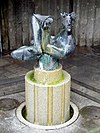
|
The Dionysus fountain, created in 1973 by Hans Karl Burgeff, reminds with the figure of the wine god of the important time of Cologne's wine-growing and trade. The sculpture stands “Am Domhof”. |

|
At the court, old town. The nature of these ancient pumps may date from the French era . |
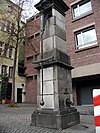
|
Old fountain on Marsplatz in Cologne's old town |

|
Bowl fountain by Olaf Höhnen from 1956 in the inner courtyard of the historic town hall complex "Spanischer Bau". A bronze fountain column tapers with three bowls from the lowest round basin and ends in a small fountain. Ball-like bulges on the column and the catch basin are decorated with colored mosaics. A picture from 1988 shows the fountain with its lower basin embedded at ground level and surrounded by a small ornamental garden. Today the fountain stands on a paved surface, surrounded by chairs and tables belonging to a restaurant. The former small green area was replaced by a few flower pots. |

|
On the north side of the Spanish building of the Cologne City Hall stands the Theo-Burauen-Brunnen, named after a Lord Mayor of the city . The fountain (also known as the town hall fountain) was donated by Wienand Müller, a former Cologne carnival prince . The bronze sculpture rising up from a concrete base was created in 1971 by the artist Klaus Albert. |
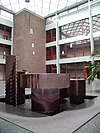
|
Fountain in the atrium of the office wing (right of the historic building). |

|
Cologne city center Museum of Applied Arts . In the inner courtyard of the museum, delimited by an old cloister, there is a fountain on the north wall of the Minorite Church. An angel standing on a high column holds a painter's palette in his hands in honor of Stefan Lochner , the famous master of the Cologne School of Painting in the Middle Ages. The sculpture created by Ewald Mataré was inaugurated in 1953 on the 500th anniversary of Lochner's death. |

|
The large-scale “Rheingartenbrunnen” facility on the World Youth Day Trail next to the Hohenzollern Bridge on the slope behind the Cologne Philharmonic was designed by Eduardo Paolozzi (1924–2005). The facility was built in 1984–1986. |
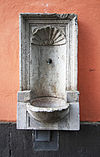
|
Wall fountain in Cologne's old town, at the eastern end of Salzgasse. Sandstone work with inlaid upper shell relief and a small water basin protruding in a semicircle. The plant is out of order. |
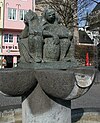
|
Fischweiberbrunnen on the historic fish market in the old town below Groß St. Martin and next to the Stapelhaus . The sculpture is the work of the sculptor Rainer Walk. |

|
Women's fountain by Anneliese Langenbach in the inner courtyard of the Farina area (above Rathausplatz). The ten figures represent women from the 15th to 19th centuries. |

|
The carnival fountain on the small Gülichplatz in front of "Haus Neuerburg" in Cologne's old town was created by Georg Grasegger (1893–1927) in 1913. Four representations from the Cologne Carnival are grouped around a round bronze basin . |

|
The opera fountain on Offenbachplatz is a concrete construction with mosaics from 1966. Parts of the glass mosaic come from the Berlin Kaiser Wilhelm Memorial Church and the luxury yacht "Christina" of the Greek shipowner Aristotle Onassis . The fountain, designed in relief by the sculptor and painter Jürgen Hans Grümmer , is equipped with a powerful fountain with a throughput of around 100,000 liters of water per operating hour. The listed mosaic fountain was presented in 2010 by the Rhenish Association for Monument Preservation and Landscape Protection as Monument of the Month to indicate that the fountain was worthy of restoration. In the course of the redevelopment plans for the entire opera quarter, public interest in restoring the opera fountain to its original state is growing. |

|
DuMont fountain on Breite Straße 90. Theo Heiermann (1925–1996) designed this artistic fountain in 1986 for the neighboring headquarters of the Cologne publishing house DuMont Schauberg . |

|
A fountain made of Lahn marble in the forecourt of the Church of St. Maria in the Kupfergasse . It is the former market fountain of Villmar an der Lahn and was set up in 1973. |

|
Fountain as a bronze bowl with a surrounding colored mosaic band. The design, reminiscent of a baptismal font, is the work of the sculptor Ewald Mataré . The fountain is located in the inner courtyard of the archbishop's palace on Kardinal-Frings Straße. |

|
The fountain on the stock exchange, created by the Braunsfeld artist Heribert Calleen , was popularly known as the "shashlik fountain" because of its elements layered on a skewer. |

|
Arno Breker fountain in the Gerling district, Gereonshof. The architect Breker was also active as a sculptor. In 1951/57, three fountain basins were created at the “Gereonshof”, the middle of which is decorated with figurines. |

|
The gardens and fountains created on the Kaiser-Wilhelm-Ring after the subway was built against the background of the Kölnturm . |
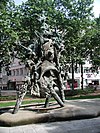
|
The six-meter-high “Fischbrunnen” on Kaiser-Wilhelm-Ring is a design by the sculptor Elisabeth Baumeister-Bühler . The work, made of bronze and granite in 1971, is a foundation of Gothaer Versicherung on the occasion of its 159th company anniversary. |

|
Fountain in the courtyard of the Neumarkt Passage . |

|
Neumarkt 18–24, Kreissparkasse Cologne , cash desk. The Cologne water fountain is originally a bronze work from 1935. It was cast by the Cologne factory schools (Eduard Schmitz) and was melted down in 1942. The current fountain was re-poured in its old shape in 1950. |

|
Water feature at the end of a corridor in the Neumarkt Passagen . |

|
The fountain is a granite fountain stele designed in 1972 by the artist Harald Frehen - then an art student under Professor Josef Jaekel at the Cologne Werkschulen . The work could be realized by the foundation of a Cologne beer distributor and received the popular name "Bierbrunnen". The fountain is a throwback to the former on the Schildergasse standing guild house of the brewer. |
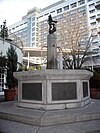
|
The "Löwenbrunnen" in the district of Altstadt-Nord commemorates 1100 murdered Jewish children from Cologne, whose names are written on the bronze plates surrounding the fountain basin. The fountain was set up in 1997 on Erich-Klibansky-Platz . |
Altstadt-Süd
| investment | Location description |
|---|---|

|
Fountain system in Cologne's inner city on Kämmergasse. The fountain set up next to the department store in the front garden is adorned with a bronze by the artist and sculptor Paul Bronisch . The work entitled "Bathers" was created in 1972. |

|
Water terraces in a semicircle around the new building of the Stadtsparkasse Rudolfplatz in the city center . |

|
Fountain in the cloister courtyard of the St. Pantaleon Abbey . |

|
Fountain in the former cloister courtyard of the Cologne Charterhouse on Kartäusergasse in Severinviertel. |

|
Ship of fools on Karl-Berbuer-Platz. The fountain was built in 1987 by the sculptor Bonifatius Stirnberg , it is reminiscent of the Cologne composer and pop singer Karl Berbuer . (Support group Karl-Berbuer-Brunnen) |

|
Disused travertine fountain from 1914 by Simon Kirschbaum. The fountain in the street "Im Dau" (height no. 9) is said to have stood in front of a school that was destroyed during the war, to commemorate the "old Fritz", who introduced the general school regulations for Prussia in 1763, according to the residents. However, it is a memory of the widow Magdalena Klotz, a granddaughter of Christoph Winters, who continued his work, the establishment of the Cologne Hänneschentheater. |

|
Cologne, the Arnold von Siegen fountain is a reminder of the Cologne mayor of the same name. The fountain in front of the "Zint Jan" (St. Johann Baptist) church, created in 1966 by the artist Elisabeth Baumeister-Bühler, is currently not in operation due to construction work. |

|
The fountain in the southern part of Cologne , "An der Eiche", was designed in 1979 by Jürgen Schreiber. The complex is designed as a small paved hill, on the top of which bronze acorns have been placed as water dispensers . |
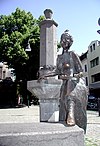
|
Severinskirchplatz at St. Severin. Severin's fountain with the figure "Stollwerck girl around 1900" was created by Sepp Hürten and erected in 1990. (Imhoff Foundation) |

|
The chocolate fountain in the Imhoff Chocolate Museum in Cologne's Südstadt is another facet in Cologne's fountain history. The fountain was designed by Fritz Eller (1927–2018) and Robert Walter. Heinz Huiskens, a machine builder from Düsseldorf , realized it. |
Neustadt-North
| investment | Location description |
|---|---|

|
The "Star Pit" fountain at the Mediapark . The amphitheater- like fountain was designed by Professor Zeidler and Otto Piene . It is the meeting point and venue of the park. |

|
The futuristic fountain on Ebertplatz , a work of art called " water kinetic sculpture ", was created by Wolfgang Göddertz from Gustorf in 1970/77. |
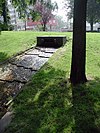
|
Water source of the park water in the facility Theodor-Heuss-Ring |

|
Fountain melting pot Nippes at Schillplatz in Cologne-Nippes by Waltraut (Waltraud) Bosse, built in 1996. The fountain (see memorial plaque in the ground) was mainly financed by shops, institutions and citizens from the " Viertel " (district). Trude Herr , Carl Sonnenschein and Willy Schetzka (1914–1984; founder of the local Radio Nord company on Neusser Straße) are commemorated on the three plaques on the base . |
Neustadt-Süd
| investment | Location description |
|---|---|

|
The fountain complex Habsburgerring 9-13 is located in a small green area between the Ringstrasse and the Hotel Steigenberger Cologne City Center. |

|
The location of the fountain is a species-rich green inner courtyard of the "Mineralogical-Petrographic Institute" of the University of Cologne . In 1968, a fountain was installed in it, supported by Bayer AG Leverkusen , based on a garden design from Cologne University, which was not only intended to be used for decoration but also for teaching purposes. The “stone fountain” was created from granite from the Fichtelgebirge and its stand, which was laid out in a semicircle with slabs of different types of stone, serves as additional visual material. |

|
The Museum of East Asian Art with its traditionally designed water garden is located at the Aachener Weiher . |

|
The water system in the inner garden in the Museum of East Asian Art on Universitätsstrasse was integrated into a traditionally designed Japanese garden in 1977 based on a design by the horticultural artist and sculptor Masayuki Nagare . The system, which is fed by the water from the neighboring Aachener Weiher, is a typical arrangement of rocks, sand and coarse pebbles with its corresponding planting, in the middle of which a well overflow creates a small watercourse. The facility was restored some time ago. |

|
Fountain in the Volksgarten pond |
Deutz
| investment | Location description |
|---|---|
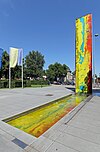
|
The towering “water sculpture”, built according to a design by Rainer Gross, New York, is located in the Cologne-Deutz district at Ottoplatz 1, in front of the entrance to the Kölntriangle building, which is over 100 meters high |

|
A monument erected in May 2009 for the deceased landlord Hans Lommerzheim in Cologne-Deutz shows a wall fountain made from a bronze relief in the beer garden of the reopened restaurant, which depicts the landlord at the beer tap. |

|
Fountain at the beginning of the street "Deutzer Freiheit" at the level of Mindener Straße |

|
On behalf of the city, the sculpture " Düxer Bock " created by Gerhard Marcks (1889–1981) was installed in Cologne-Deutz in 1963 . Adorned by a fountain column, it stands in a small front yard on Gotenring at Arnoldstrasse. |

|
Old pump well on the Deutz Reischplatz |

|
The Tanzbrunnen in Cologne-Deutz , between the Koelnmesse grounds and the adjoining Rheinpark , was designed in 1957 by Josef Op Gen Oorth . A tent construction by the architect Frei Otto spans an open-air stage. |
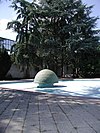
|
The mushroom-like fountain (ø120 cm) was designed by the Cologne artist Hannelore Wiese. It stands in the front eastern area of the Rheinpark. |

|
Fountain in an elongated pond on the eastern edge of the Rheinpark (Auenweg) |

|
The hedgehog fountain stood near the Rosenhof in the Rheinpark (damaged or destroyed by vandalism). It was a work of bronze mounted on a stone plinth, created by Fritz Bernuth in 1960 . |

|
Fountain for the 1957 Federal Horticultural Show in the “Adenauerweiher” in the Rheinpark |

|
Water feature for the 1957 Federal Horticultural Show in the Rheinpark by Josef Jaekel |

|
Fountain garden for the 1957 Federal Horticultural Show in the Rheinpark by Joachim Winkler and Günther Schulze . The complex was Monument of the Month July 2009 of the Rhenish Association for Monument Preservation . It comprises fourteen basin wells, whose basins consist of around 100,000 Rhine pebbles , and four bowl wells . These are spread over an area of 4,000 square meters. With the help of voluntary work from the Brunnengarten im Rheinpark eV association and the Ford -Werke GmbH training workshop, the spring wells were renovated and restored to their original condition in April 2012. |

|
Mineral water fountain (Gesundbrunnen) in the Rheinpark. The water was pumped from a depth of 270 m. The well is shut down. The water is used by the adjoining thermal bath "Claudius-Therme". |

|
Water terraces for the Federal Horticultural Show 1957 .
“In the area of the water terraces, the garden architect Herta Hammerbacher transformed the gently modeled topographical situation into a playful interrelationship between landscape, water, horticultural and structural design. The water terraces have been preserved in their original form to this day filled with earth and planted. " Source: City of Cologne |
Suburbs
Left of the Rhine
| investment | Location description |
|---|---|

|
Cologne-Pesch , garden area of a housing estate. On the land of the Bollig family in Pesch, large new residential areas were built next to a new motorway route in the 1960s . In the middle of the rows of houses in one of these quarters, between Hubertus and Sebastianusstrasse, the client at the time (the late senior of the Bollig family) had a fountain built, which was popularly known as the "Feschbrunnen" and which stood dry for a long time. The dialect poet Heribert Klar, who has become a new citizen of Pesch , took this as an opportunity to ponder this new “Pötz” in his neighborhood and to write a poem in Rhenish dialect . This well poem, which was written at the time, can be read in a 1993 posthumously published anthology of his stories under the title “Wo et Hätz vun voll es”. |

|
Lindenthal , Stadtwaldgürtel 18, behind the Cologne High School and Foundation Fund (KGS): the history fountain designed by Hon Sang Tong was inaugurated in 2004 and is intended to symbolically illustrate the history of the KGS. |

|
Lindenthal , Universitätsstr. 33 (between the university library and the lecture hall building): The play fountain was designed in 1967 by Jürgen Hans Grümmer . The facility, which was designed as accessible, had to be partially dismantled due to repeated destruction. |

|
Cologne-Fühlingen , Arenzhofstraße, 38. Fountain complex of the Arenzhof residential park, which was developed from a courtyard complex from the early 19th century |

|
Cologne-Riehl, Amsterdamer Strasse Children's Hospital . The fountain system in front of the main entrance, consisting of four exposed aggregate concrete basins, was installed in 1962 based on a design by Professor Benno Schachner (1902–1987). |

|
Flora Cologne, main fountain, on the left side
The fountain system placed between the main entrance and the main Flora building is equipped with a wreath of fountains. The complex was originally built in 1862 according to plans by Peter Joseph Lenné and is of monumental size. |

|
A water terrace framed by hornbeams in Cologne's botanical garden , the Flora , in front of the outdoor seating area of the café there. This cascade system also goes back to plans by Peter Joseph Lenné from 1862/64. |
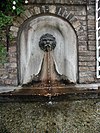
|
Flora Cologne, wall and ornamental fountain on the main building left and right. The detail shows a bronze lion head as a gargoyle. The fountains are also designed by Peter Joseph Lenné. |

|
The fountain in the Finkenplatz green space in Cologne-Niehl, designed by Fritz Encke , was built in 1912. The round fountain bowl, framed by five columns and a narrow wrought-iron grille at the top, is currently filled with soil. According to an attached notice, a donation from Deutsche Exxon Chemical GmbH in Cologne-Niehl made it possible to restore the fountain in 1998. |

|
A section of the inner green belt is a small park, the so-called “Alhambra” in the Cologne-Nippes district, located between Merheimer Platz and Escher Strasse, which opens onto Innere Kanalstrasse . The centerpiece of this strictly symmetrical complex is a “sunken garden” (sunken perennial garden) with a fountain in the center, probably based on Karl Foerster's (1874–1970) ideas. This central fountain and a small wall fountain on the north side at the end of the park have been dry for years. |

|
Rheinenergie Park Cologne. Modern ornamental fountain in the park area between the main building of the "GEW" (Bilderstöckchen / Ehrenfeld) and the motorway |

|
The Barbarabrunnen in Cologne-Neuehrenfeld was built around 1927/28 in Ennenstraße and is labeled “H. Geier ”signed. The sculpture of the well stock made of shell limestone rises on a brick base, whose gargoyles supply the pool surrounding it. The facility, framed by a lattice, is reminiscent of a custom, according to which on the eve of the feast of St. Barbara , she filled the shoes of the children who slept at night with apples and nuts after they had cleaned their shoes. The “Barbar Anniter” carnival society sponsored the fountain. |

|
The Max-und-Moritz-Brunnen set up in Neuehrenfeld on Lenauplatz is the work of the artist Hein Derichsweiler . The cast iron work was created in 1960 and is a foundation of the local community. |

|
The fountain of the "three ice saints" has stood in Gravensteiner Strasse in Neuehrenfeld since 1999. This refers to the founders of the non-profit housing association Ehrenfeld, which has existed since March 7, 1899 : Rector Franz-Peter Schmitz (1860–1947), Josef Vasters (1856–1937) and Wilhelm Steinkrüger (1863–1941), stylized by three stone figures in a circular one Pool. The figure standing outside the pool stands for their successor Jakob Schupp. |

|
Lasche Nas or Andreas Leonhard Lersch (1840–1887) was a butcher, actor , district coverer , city dog catcher and executioner . In his honor there is a fountain in front of the Ehrenfeld district town hall. |

|
The fountain in front of the Ehrenfeld Neptunbad is decorated with a historical "Kappesboor" (Kohlbauer) sitting on a box filled with cabbage. The sculpture is the work of the sculptor Fritz Fein-Jankowski and was erected in 1993. |

|
Just like the blood column in St. Gereon , the fountain next to today's St. Mechtern Church (a former monastery) reminds of the executed martyrs of the "Theban Legion". The basin made of shell limestone was erected in 1927. |

|
The Barthonia fountain at Venloer Straße 251 in Ehrenfeld bears the name of the investor “Barth” who converted the former “Mülhens site” ( 4711 ) into office, business and commercial purposes. The approximately 2.60 m high, tapering sculpture was designed by the Cologne artist Willi Neffgen. Without the name “Barthonia Forum” running around the bottom, it is equipped with a further 530 characters, which were taken from 14 past or existing cultural and linguistic areas. The characters used vary in size, thickness and shape, are sometimes reversed or upside down. The original sculpture stimulates reflection and is an enrichment of the cityscape. |
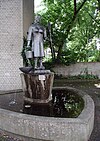
|
The "Schnüsse-Tring-Brunnen" set up in front of the Rochus Church in Cologne-Ossendorf is intended to commemorate Katharina von Ossendorf, a daughter of the former landlord "Om Wissel". Since the young woman is said to have been quick-witted, she was nicknamed "Schnüsse Tring" (Schnüss = mouth). |

|
The Nonnibrunnen in Cologne-Ehrenfeld was set up around 1965 on a small square by the church of St. Bartholomew on Melatener Weg. It is a bronze by the artist Lambert Schmitthausen. The sculpture of the fountain depicts a young person reading and is intended to commemorate the youth author Jón Sveinsson (Nonni), who died in Cologne in 1944 . Next to the figure is a small concrete basin on the ground floor, which is now filled with pebbles. |
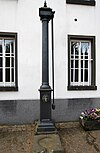
|
Cologne-Junkersdorf , Stüttgenweg. Pump for the well of the Stüttgenhof farm from the 19th century. |

|
Thanks to a foundation by the Gerling Group, a larger water system was built in the new residential area on Lübecker Strasse in Cologne-Weiden . The facility, which was realized in 1973/74, was designed according to a design by the Cologne architects Mronz . The large pond-like basin with two fountains is embedded in a small green area between the rows of houses and is freely accessible from the street. |

|
Fountain in the old churchyard in Müngersdorf |

|
The "Panbrunnen" erected on Pauliplatz in Cologne-Braunsfeld was created by an unknown artist. The sandstone fountain was probably built at the beginning of the 20th century and is said to have been shown at the Cologne Werkbund exhibition before 1914. |

|
The putti fountain in bronze and stone was created in 1953 by Arno Breker and is a foundation of the Gerling Group. It is located in a garden courtyard of the residential building area on Aachener-, Clarenbach- and Brucknerstraße in Cologne-Lindenthal . The fountain stele rising from a round basin is crowned by a putto standing on a ball, each holding a fish in his hands. The sphere and a wreath at the end of the stele originally supplied the basin with a water cycle, which has now been shut down. |

|
According to a design by Georg Grasegger , two centaurs made of shell limestone were erected in 1930 on the Lindenthal Canal on Rautenstrauchstrasse in Cologne-Lindenthal . |

|
A futuristic fountain in Lindenthal at Dürener Strasse 393. The entrance area of an office building is adorned with a bronze light and water fountain. It is a design by Heribert Callen from 1980. |

|
Cologne-Lindenthal, fountain in the former monastery garden of St. Anna's house |

|
Cologne-Lindenthal, An St. Laurentius 1. Fountain in the inner courtyard of the Catholic Church of St. Laurentius. The overall St. Laurentius complex designed by the architect Emil Steffann was awarded the Cologne Architecture Prize and was included in the list of architectural monuments in the Cologne district of Lindenthal . |

|
The horticultural director Fritz Encke 1905 to 1907 on the western edge Klettenberg scale Klettenbergpark fed his pond formerly by the Regional Huerth springing Duffesbach, but today with tap water. |

|
On Luxemburger Strasse
Between the tall buildings of the district and regional court and the employment office , a well was built in 1986 based on a design by Wolfgang Kuhn. It is a spherical fountain made of Sardinian granite from the region of Monte Ortobe . The well decorated with flowers is currently not in use. |
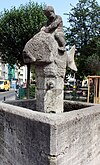
|
Fischreiterbrunnen Cologne-Zollstock , Theophanoplatz. The sandstone fountain was built around 1913 based on a design by Georg Grasegger . The founder of the fountain was the Rheinisch-Westfälische Bank for real estate in Essen, whose name was incorporated on the edge of the pool.
|

|
The “Puttenbrunnen” facility in the Cologne-Marienburg district is at the southern end of the Parkstrasse there in front of the main entrance of the Marienburg villa, which gives the district its name . A fountain stick adorned with four putti rises from the oval bowl fountain made of limestone. Two of these sculptures in the form of children are sitting, the two standing are holding a bowl with raised arms, from which the water cycle of the fountain begins. |

|
The small facility in the Cologne-Rodenkirchen district is at the entrance to the so-called Rheingalerie on Kirchstrasse. The marble stele framed by coarse Rhine pebbles was made in 1986 based on a design by the Mronz architects' office. |

|
The fountain in the Forest Botanical Garden is in the center of the Rodenkirchen complex.
The “Mühlsteinbrunnen” from 1964 was based on an idea by Walter Franz and was realized by the garden architect Kurt Schönbohm . |
Right bank of the Rhine
| investment | Location description |
|---|---|

|
Ball fountain and seating blocks in the pedestrian zone on Bahnhofstrasse Cologne-Porz . The system, designed as a water feature, was a design by Gottfried Kühn in 1974, but is no longer in function. Kühn received the Cologne Architecture Prize (1975), which was the first time a garden architect was awarded in his person. |

|
The Groov peninsula on the Rhine in Cologne-Zündorf was used for pollinated willows and vineyards until the middle of the 18th century . Today it is also a popular leisure activity in the city. The water and garden facility was built in 1972 based on a design by the architects Kühne, Schubert and Partners. The fountain ring is located in a disused arm of the Rhine. |

|
The Milchmaidbrunnen in Cologne-Poll stands at the end of a small green area of the Efeuplatz. It was built around 1930 by Schreiner and von Mehring. The stone fountain was a foundation of the "Gemeinnützigen AG for housing construction". The system is no longer in operation as a well. |
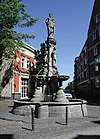
|
Mülheim's city fountain , the "Mülheimia", is on the street Mülheimer Freiheit, at the corner of Krahnenstrasse. The erection of a fountain was suggested on the initiative of the last mayor of the city of Mülheimer an Rhein, Bernhard Clostermann , and was implemented in 1884 based on a design by the Cologne sculptor Wilhelm Albermann . The cost of the well, which remained the only such facility in Mülheim until 1913, amounted to 9,500 marks at that time. In 1965, Eduard Schmitz carried out repairs with supplementary work on the fountain basin. |

|
At the end of Cologne-Mülheimer Keupstraße on the Rhine side, a fountain system was built in 1984 on a small open space. It got its original name "Rheinbrunnen" after the rock that formed it from the headwaters of the Rhine ( Tavetsch in the Swiss canton of Graubünden ), from which it was created according to a design by "Michael te Reh". The artist also designed and built the fountain on Poller Marktplatz and the village fountain in Roßdorf. A large ship anchor added by te Reh rounded off the symbolic reference to the nearby river Rhine. It got its popular name Dreikönigen Brunnen from its location, which is opposite the former Dreikönigen Hospital founded by Maria Sybilla Petronella Keup, the widow of the Mülheim grain dealer Kaspar Keup (after being demolished, there is now a new retirement home). The fountain is in operation and its decorative anchor is in place. |

|
The construction of the Genoveva fountain goes back to the initiative of Mülheim city councilor Michael Laufenberg, who campaigned for the beautification of Mülheim even before the city of Mülheim am Rhein was incorporated into the city of Cologne. He was able to win over the widow of the manufacturer Martin, co-founder of the Mülheim company Martin & Pagenstecher, for his plan to install a fountain in front of what was then the high school . Ms. Martin commissioned the sculptor and church painter Adalbert Hertel , by whom the work of art was completed in March 1914 and given to the city as a foundation by the Martin family.
The fountain is a life-size bronze that rises from a basin on a pedestal. The location remained in front of the school building, now known as the Genoveva high school. The facility stands in a small green area on Cologne-Mülheimer Genovevastraße and, like the naming of the street, the school and the nearby Genoveva baths, reminds of the legend of St. Genoveva . |

|
The Mülheim "Schifffahrtsbrunnen" is the remnant of an original pair of fountains created by Hans Wildermann around 1912 . It was the works made of stone and bronze that received the name Trade and Shipping Fountain. The works shown at a Düsseldorf city exhibition in 1912 were installed in Mülheim at the instigation of the Mülheim Beautification Association and the Mülheim-based Kabelwerke Felten & Guilleaume . The two fountains, which are identical in structure except for the crowning of the figures, were built on Clevischer Ring. The trade well equipped with the god Mercury as a symbol of economic success stood at the north end, the female figure holding an anchor in the shipping fountain at the south end of the Clevischer Ring referred to shipping, which is important for the state. In 1927 it was dismantled and taken to a depot. The well had to give way to the construction of the permanent Mülheim bridge , which replaced the previous Mülheim ship bridge . The trade fountain, like many other Cologne fountains, was destroyed in the Second World War. Today the remainder of the shipping fountain is on the southeast side of Wiener Platz . For reasons that cannot be researched, but can be seen from our own experience, the two meter-sized bronze mussel shells, which the youngsters held on horses, over which the well water once ran, have been missing since 2012. |

|
The “Animal or Fairy Tale Fountain” in the Cologne-Mülheim district is at the southeast end of Jan-Wellem-Straße , at the upper entrance to the Mülheim city garden . The fountain, made of sandstone and bronze , was built in 1914 according to a design by the Cologne sculptor Wilhelm Albermann. The group of boys on the fountain stick rising up in the middle of the large basin is surrounded by four life-size animals that rest on plinths and fill the basin as gargoyles. However, the plant has been dry for some time. < [1] > |

|
The Mülheimer Stadtgarten , located in the Cologne-Mülheim district , was created in 1912/13. Its current shape is essentially based on the design by the garden architect Theodor Nussbaum from 1928. The centerpiece of the garden is the small lake equipped with a fountain. |

|
In the Cologne-Dellbrück district, right next to the Cologne-Thielenbruch Tram Museum , not far from Gemarkenstrasse, is the “Thielenbruch Ball Fountain” (sometimes also known as the “Globe Fountain”), designed as a black marble earth figure about one meter in diameter. |
literature
- Hans Vogts , Fritz Witte: The art monuments of the city of Cologne , on behalf of the provincial association of the Rhine province and the city of Cologne. Published by Paul Clemen , Vol. 7, Section IV: The profane monuments of the city of Cologne , Düsseldorf 1930. Verlag L. Schwann, Düsseldorf. Reprint Pedagogischer Verlag Schwann, 1980, ISBN 3-590-32102-4 .
- Konrad Adenauer, Volker Gröbe : Streets and squares in Lindenthal . JP Bachem Verlag, Cologne 1992, ISBN 3-7616-1018-1 .
- Leonard Ennen , Gottfried Eckertz (Hrsg.): Sources for the history of the city of Cologne. Volume 3. DuMont-Schauberg, Cologne 1867, p. 24/25, No. 31: Judenpütz, lapis lavatorius, old Roman wall. - 1270, October 24th. From a fascicle of the Judeorum shrine in the archives of the regional court. , (Reprint. Scientia Verlag, Aalen 1970, ISBN 3-511-04763-3 ).
- Ute Fendel: Culture Paths Cologne-Lindenthal . District representation Cologne-Lindenthal, Cologne 2000.
- Mr. R. Jung : The city forest in Cologne. In: Journal of Horticulture and Garden Art. Vol. 14, 1896, No. 43, pp. 313-316. (PDF; 1.1 MB), No. 44, pp. 319–321. (PDF; 1.0 MB), No. 45, pp. 325–327. (PDF; 966 kB).
- Hermann Keussen : Topography of the City of Cologne in the Middle Ages (= price publications of the Mevissen Foundation 2). 2 volumes. Hanstein, Cologne 1910 (reprint. Droste, Düsseldorf 1986, ISBN 3-7700-7560-9 and ISBN 3-7700-7561-7 ).
- Johannes Maubach: Across Ehrenfeld. Ehrenfeld history trail . Part 1. Flock printing, Cologne 2001.
- Yvonne Plum: Cologne fountain. A walk through Cologne's old town and Südstadt. Hayit Verlag, Cologne 1992, ISBN 3-89210-380-1 .
- Birgit Schilling, Karl Heinz Thurz: Fountain in Cologne . JP Bachem Verlag, Cologne 1988, ISBN 3-7616-0936-1 .
- Partly existing data information on the objects
Individual evidence
- ↑ Information from the Roman-Germanic Museum in Cologne
- ↑ excavation findings under the "Cäcilium" in a publication of the Cologne City Gazette of 16 November 2007, Carl Dietmar. Retrieved December 13, 2009 from Where the Ancient Romans Sweated
- ^ Hermann Keussen , Volume I, p. 5, with reference to "Liber historiae Francorum" (Ser.Ber.Merow.II) 250: In illis diebus coepperunt Franci Agrupunam civitatem
- ^ Adolf Thomas, reference to Ennen and Eckertz, Urk. IV, p. 295.
- ^ Leonard Ennen, History of the City of Cologne, I., p. 682.
- ↑ Leonard Ennen, from a fascination of the Judeorum shrine in the archives of the regional court.
- ↑ Keussen, Vol. I, p. 173, reference to the commemorative publication: The lighting and water supply of the city of Cologne (1895), 89/90.
- ↑ Günther Binding, p. 112.
- ↑ a b Keussen, vol. I, p. 171, reference to the commemorative publication: The lighting and water supply of the city of Cologne (1895), 89/90.
- ↑ Hermann Keussen, Vol. I, p. 171 ff.
- ↑ Keussen, vol. I, p. 172, reference to Hermann von Weinsberg: This reported about the shared use of the Pütz in his house Cronenberg. On this occasion, Weinsberg spoke in detail about such “righteous people”. Ms. IV 66 b
- ↑ Keussen, Vol. I, p. 171, reference to Stein: Akten II 27 n.9.
- ↑ Keussen, Vol. I, p. 172, reference to Schreinsbuch St. Peter: Schrb. Petri Gen. 1381 14/12; 1397 10/10
- ↑ Keussen, Vol. I, p. 173, reference to Schickungsbuch: (C 17), 104 a (1479)
- ^ Keussen: Topography of the City of Cologne in the Middle Ages. Vol. II, p. 229.
- ↑ Keussen, vol. I, p. 171, reference to the drawings Vinckenboom: Zeitschrift für christl. Art 23 (1910), 43/4, 47/8.
- ↑ a b c d e f g h i j k l m n o p q r s t u v w x y z aa ab ac ad ae af ag ah ai aj ak Birgit Schilling: Brunnen in Köln Köln, Bachem 1988.
- ^ Gerd Michel: The thermal water of Cologne. In: Geological map of North Rhine-Westphalia, explanations on sheet C 5106 Cologne, Krefeld 1986, pp. 56–57.
- ^ Karl Fricke: Geological, hydrological and hydrochemical results of the new mineral water drilling of the city of Cologne on the exhibition grounds in Cologne-Deutz (Messebrunnen III) . Water - Abwasser, Volume 164, 104th year, Issue 12, 1963, p. 336.
- ^ Karl Fricke: Geological, hydrological and hydrochemical results of the new mineral water drilling of the city of Cologne on the exhibition grounds in Cologne-Deutz (Messebrunnen III) . Water - Abwasser, Volume 164, 104th year, Issue 12, 1963, p. 337.
- ↑ Archived copy ( memento of the original from May 26, 2010 in the Internet Archive ) Info: The archive link was inserted automatically and has not yet been checked. Please check the original and archive link according to the instructions and then remove this notice. Last accessed September 6, 2008.
- ↑ Carl Dietmar, pp. 504, 543.
- ^ Yvonne Plum, p. 28.
- ^ Vogts, Witte: Die Kunstdenkmäler der Stadt Köln , on behalf of the Provincial Association of the Rhine Province and the City of Cologne. (Ed.) Paul Clemen, Vol. 7, Section IV: The profane monuments of the city of Cologne. Public monuments p. 580 ff.
- ^ The Petrusbrunnen in Cologne - fundraising campaign of the Cologne civil society from 1863 , accessed on November 12, 2018.
- ↑ Sara Miebach: "Drüjje Pitter": Plätschern auf der Papstterrasse , article in the Kölner Stadt-Anzeiger from July 4, 2010, accessed on November 12, 2018.
- ^ Yvonne Plum, p. 22.
- ^ Yvonne Plum, p. 61.
- ↑ Report from the Cologne internet newspaper report-k.de under the headline Rheinpark: Water features draw filigree fountains in the fountain garden , accessed on April 24, 2012 at report-k.de
- ↑ Konrad Adenauer, Volker Gröbe: Lindenthal. The development of a Cologne suburb. Bachem, Cologne 2004, p. 117, ISBN 3-7616-1603-1 .
- ↑ Johannes Maubach: Across Ehrenfeld, Ehrenfelder Geschichtspfad (Part 2). Self-published, Cologne, 2002, p. 51.
- ↑ Johannes Maubach, p. 77 ff.
- ^ Johann Bendel: The city of Mülheim am Rhein, history and description, legends and stories. Section well systems p. 247.
- ^ Ilse Prass: Mülheim am Rhein. City history in street names, p. 112 f.
media
- Rheinhard Zeese: Historical parks and public gardens in Cologne 1801 to 1932. CD, LEB - Brühl, 2007.









